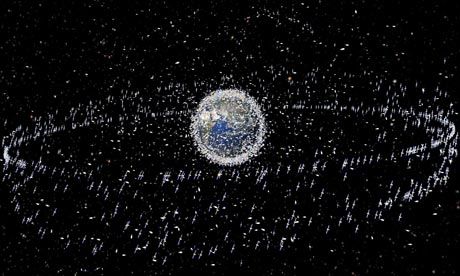You may have heard that there is a possibility that 3200 could be beaten by space junk, on Friday, when six tons NASA UARS (Satellite Upper Atmosphere Research) is expected to enter Earth's atmosphere and Earth hits.
The number of a report by the office of the NASA orbital debris program that has been circulating. But according to Scientific American magazine and NBC News correspondent Tom Costello, who is not entirely accurate.
Scroll down for a major update
Scientific American, John Matson reporting:
The State indicated incorrectly that the probability that a particular person (say, ME) will be affected by the debris of the upper airway resistance syndrome. In fact, my chances of being struck by the syndrome of the upper airway resistance on Friday around 1 to 21 trillion, since the risk is spread over almost all of the Earth, 6.7 billion people .
But if you live in North America, do not worry, according to the latest update of NASA UARS is expected to return to the Earth's atmosphere on the afternoon of Friday, Eastern Daylight Time, and the satellite over North America at that time.

What is space debris?
Orbital debris, or "space debris" is man-something that is in orbit around the Earth, and not be used, according to NASA. This includes old ship launchers and even paint stains.
NASA says there are over 22,000 pieces of space debris that are 4 inches or more. There are tens of millions of particles that are 0.4 inches, however.
When you are in low Earth orbit space debris flying from April to May miles per second. According to CNN, when they reach the Earth's atmosphere, they slow down considerably, although they can still roll up to 100 miles per hour.
In 1979, landed the part of the Skylab space station in Western Australia and the Indian Ocean.
Has anyone been hit by space debris?
According to NPR, Lottie Williams of Tulsa, Oklahoma, is the only person who really affected by space debris. In 1997, she was hit in the shoulder by a piece of what he thought was the Delta II rocket.
Williams told Fox News that she felt a tap on the shoulder as she walked in a park one morning, but when she turned, there was no one behind.
Fox News:
"The weight is comparable to an empty box," said Williams FoxNews.com. "It looked like a piece of cloth, except when you press it, it sounded metallic."
UPDATE: September 23 23:55 BST
Friday morning, NASA said that because the satellite is slowed, the latest forecasts, the satellite will make a return at late Friday or early Saturday EST. It 'been a small case - and no chance - and the decline of the U.S. Space Junk.
Associated Press:
Solar activity is no longer a significant factor in landing the satellite. Rather, its focus is apparently changed, and slows its fatal plunge.
Late Friday morning, NASA, has warned there is now a low probability of surviving debris immigrants in the United States. Earlier this week, NASA said North America would be clear.
NASA said the agency has a better idea of the position of the return of the next 12-18 hours.
Check again.
Click here to see more USAR re-entry.
Watch: Animated analysis UARS orbit and return to the model:





 11:39 AM
11:39 AM
 Admin
Admin

 Posted in:
Posted in: 



0 comments:
Post a Comment